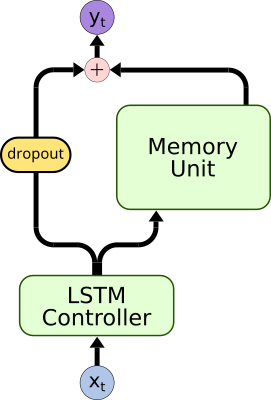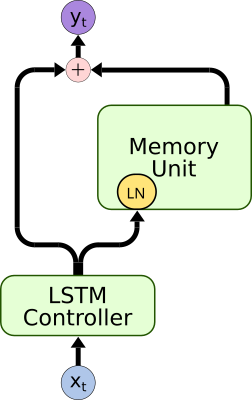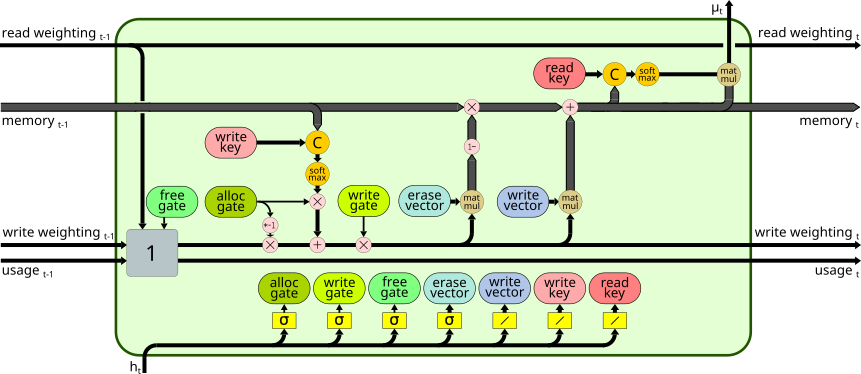| adnc | ||
| experiments/pre_trained | ||
| images | ||
| scripts | ||
| test | ||
| .gitignore | ||
| .travis.yml | ||
| LICENSE | ||
| README.md | ||
| requirements-gpu.txt | ||
| requirements.txt | ||
| setup.py | ||
Advanced Differentiable Neural Computer
This repository contains a implementation of a Advanced Differentiable Neural Computer (ADNC) for a more robust and scalable usage in Question Answering. This work is published on the MRQA workshop at the ACL 2018. The ADNC is applied to the 20 bAbI QA tasks with SOTA mean results and to the CNN Reading Comprehension Task with passable results without any adaptation or hyper-parameter tuning.
The repository contains the following features:
- Modular implementation of controller and memory unit
- Fully configurable model/experiment with a yaml-config-file
- Unit tests for all key parts (memory unit, controller, etc. )
- Pre-trained models on bAbI task and CNN RC task
- Plots of the memory unit functionality during sequence inference
- The following advancements to the DNC:
Please find detailed information about the advancements and the experiments in
- MRQA 2018 paper submission Robust and Scalable Differentiable Neural Computer for Question Answering
- My master thesis about the Advanced DNC for Question Answering with a detailed DNC/ADNC description.
The plot below shows the impact of the different advancements in the word error rate with the bAbI task 1.
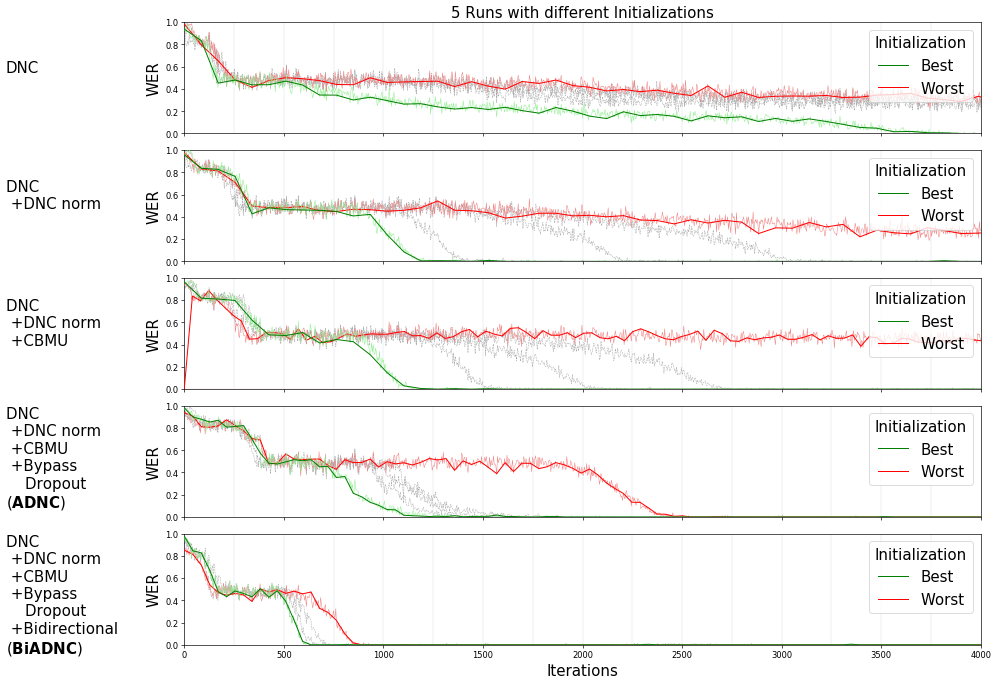 |
|---|
Furthermore, it contains a set of rich analysis tools to get a deeper insight in the functionality of the ADNC. For example that the advancements lead to a more meaningful gate usage of the memory cell as you can see in the following plots:
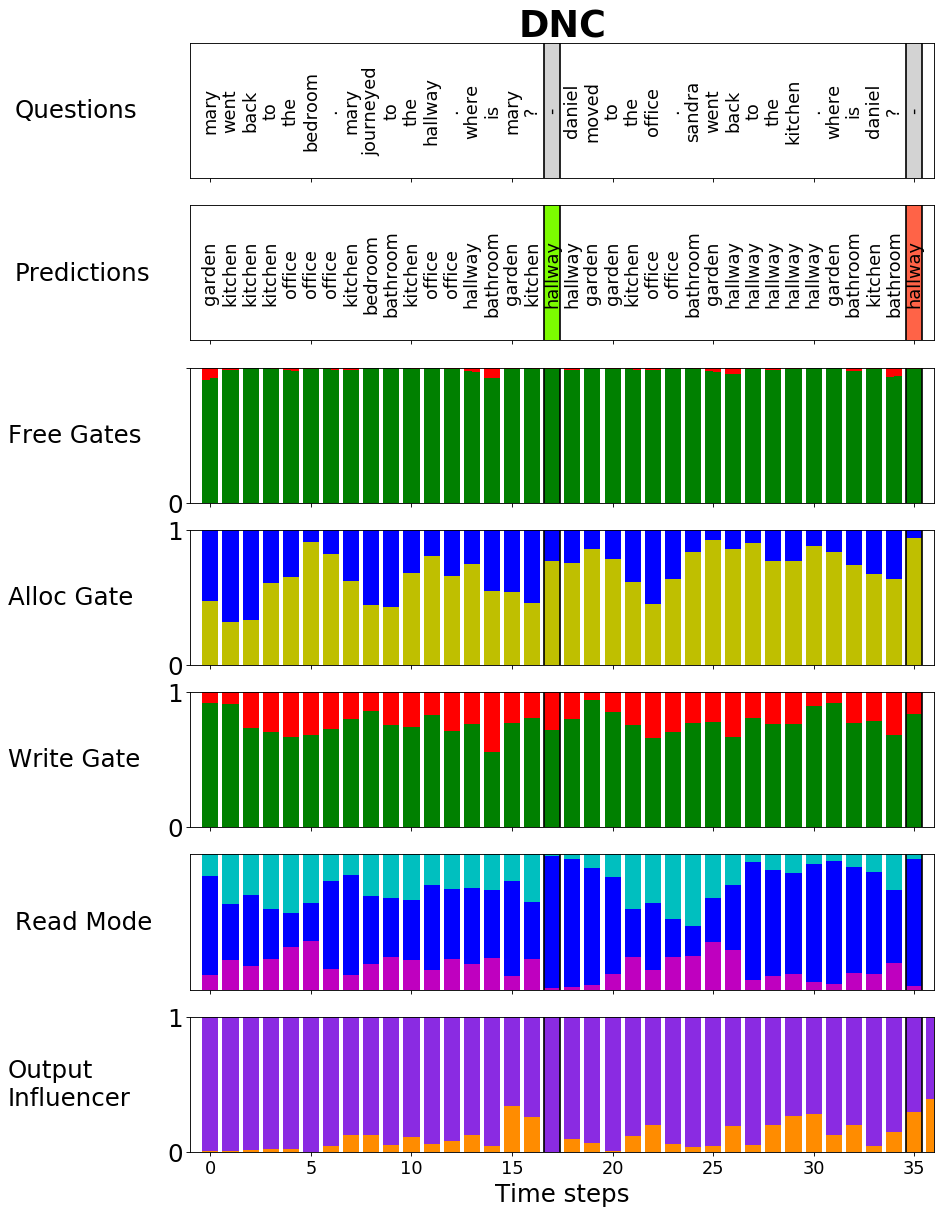 |
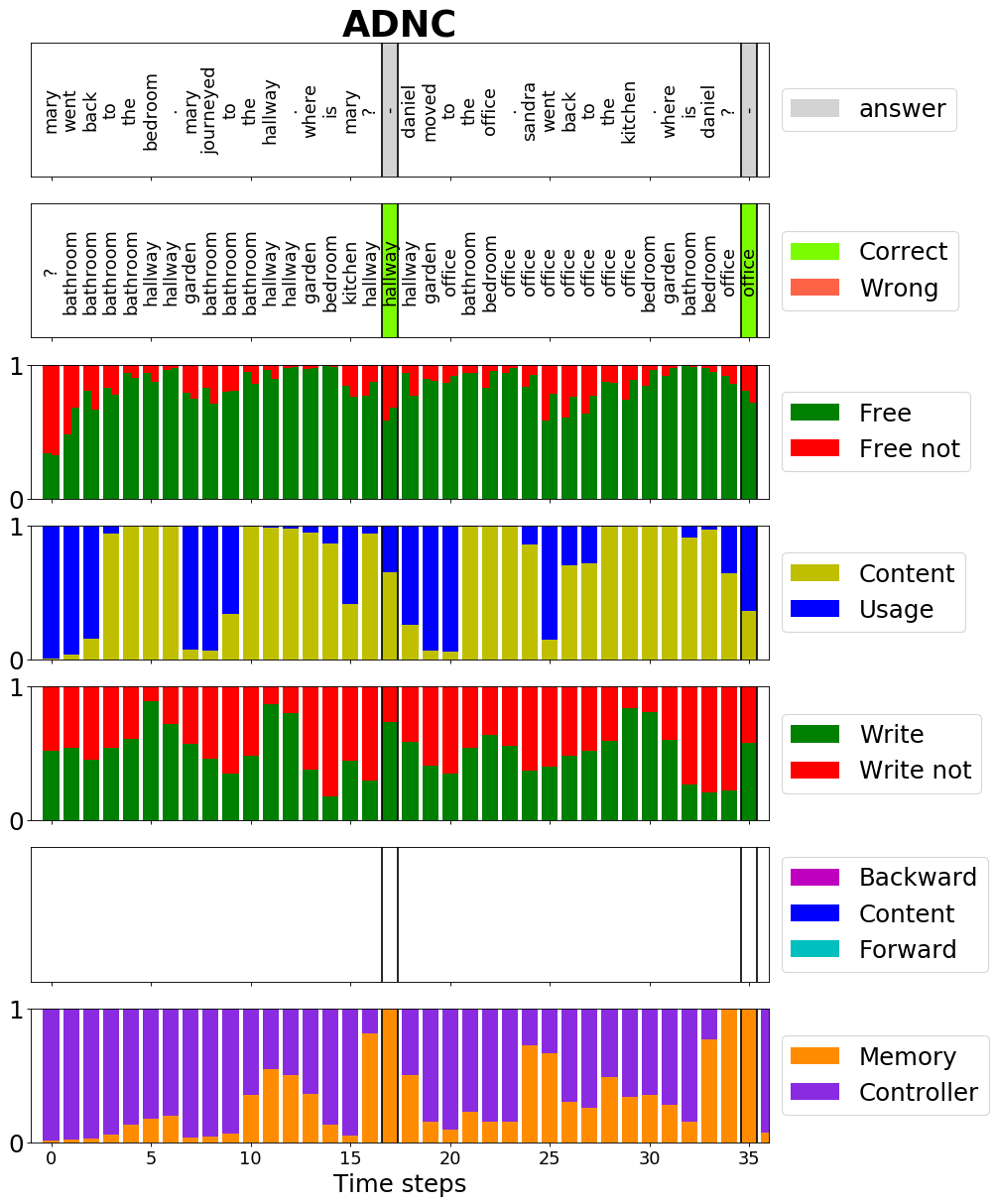 |
|---|
How to use:
Setup ADNC
To setup an virtual environment and install ADNC:
git clone https://github.com/joergfranke/ADNC.git
cd ADNC/
python3 -m venv venv
source venv/bin/activate
pip install -e .
Inference
The repository contains different pre-trained models in the experiments folder.
For bAbI inference, choose pre-trained model e.g. adnc and run:
python scripts/inference_babi_task.py adnc
Possible models are dnc, adnc, biadnc on bAbi Task 1 and biadnc-all, biadnc-aug16-all for all bAbI tasks with or without augmentation of task 16. The augmentation provides equal word distribution during training.
For CNN inference of pre-trained ADNC run:
python scripts/inference_babi_task.py
Training
The configuration file scripts/config.yml contains the full config of the ADNC training. The training script can be run with:
python scripts/start/training.py
It starts a bAbI training and plots every epoch a function plot to control the training progress.
Plots
To plot a function plot of the bAbI task choose pre-trained model e.g. adnc and run:
python scripts/plot_function_babi_task.py
Possible models are dnc, adnc, biadnc on bAbi Task 1 and biadnc-all, biadnc-aug16-all for all bAbI tasks with or without augmentation of task 16.
Experiments & Results
20 bAbI QA task
- Joint trained on all 20 tasks.
- Mean results of 5 training runs with different initializations.
- Similar hyper-parameter as the original DNC
- The unidirectional controller has one LSTM layer and 256 hidden units and the bidirectional has 172 hidden units in each direction.
- The memory unit has 192 locations, a width of 64 and 4 read heads.
- Bypass Dropout is applied with a dropout rate of 10%.
- The model is optimized with RMSprop with fixed learning rate of 3e-05 and momentum of 0.9.
- Task 16 Augmentation: The task contains a strong local minimum. Given the most common color as answer leads to a correct answer in 50% of the cases.
bAbI Results
| Task | DNC | EntNet | SDNC | ADNC | BiADNC | BiADNC +aug16 |
|---|---|---|---|---|---|---|
| 1: 1 supporting fact | 9.0 ± 12.6 | 0.0 ± 0.1 | 0.0 ± 0.0 | 0.1 ± 0.0 | 0.1 ± 0.1 | 0.1 ± 0.0 |
| 2: 2 supporting facts | 39.2 ± 20.5 | 15.3 ± 15.7 | 7.1 ± 14.6 | 0.8 ± 0.5 | 0.8 ± 0.2 | 0.5 ± 0.2 |
| 3: 3 supporting facts | 39.6 ± 16.4 | 29.3 ± 26.3 | 9.4 ± 16.7 | 6.5 ± 4.6 | 2.4 ± 0.6 | 1.6 ± 0.8 |
| 4: 2 argument relations | 0.4 ± 0.7 | 0.1 ± 0.1 | 0.1 ± 0.1 | 0.0 ± 0.0 | 0.0 ± 0.0 | 0.0 ± 0.0 |
| 5: 3 argument relations | 1.5 ± 1.0 | 0.4 ± 0.3 | 0.9 ± 0.3 | 1.0 ± 0.4 | 0.7 ± 0.1 | 0.8 ± 0.4 |
| 6: yes/no questions | 6.9 ± 7.5 | 0.6 ± 0.8 | 0.1 ± 0.2 | 0.0 ± 0.1 | 0.0 ± 0.0 | 0.0 ± 0.0 |
| 7: counting | 9.8 ± 7.0 | 1.8 ± 1.1 | 1.6 ± 0.9 | 1.0 ± 0.7 | 1.0 ± 0.5 | 1.0 ± 0.7 |
| 8: lists/sets | 5.5 ± 5.9 | 1.5 ± 1.2 | 0.5 ± 0.4 | 0.2 ± 0.2 | 0.5 ± 0.3 | 0.6 ± 0.3 |
| 9: simple negation | 7.7 ± 8.3 | 0.0 ± 0.1 | 0.0 ± 0.1 | 0.0 ± 0.0 | 0.1 ± 0.2 | 0.0 ± 0.0 |
| 10: indefinite knowledge | 9.6 ± 11.4 | 0.1 ± 0.2 | 0.3 ± 0.2 | 0.1 ± 0.2 | 0.0 ± 0.0 | 0.0 ± 0.1 |
| 11: basic coreference | 3.3 ± 5.7 | 0.2 ± 0.2 | 0.0 ± 0.0 | 0.0 ± 0.0 | 0.0 ± 0.0 | 0.0 ± 0.0 |
| 12: conjunction | 5 ± 6.3 | 0.0 ± 0.0 | 0.2 ± 0.3 | 0.0 ± 0.0 | 0.0 ± 0.1 | 0.0 ± 0.0 |
| 13: compound coreference | 3.1 ± 3.6 | 0.0 ± 0.1 | 0.1 ± 0.1 | 0.0 ± 0.0 | 0.0 ± 0.0 | 0.0 ± 0.0 |
| 14: time reasoning | 11 ± 7.5 | 7.3 ± 4.5 | 5.6 ± 2.9 | 0.2 ± 0.1 | 0.8 ± 0.7 | 0.3 ± 0.1 |
| 15: basic deduction | 27.2 ± 20.1 | 3.6 ± 8.1 | 3.6 ± 10.3 | 0.1 ± 0.1 | 0.1 ± 0.1 | 0.1 ± 0.1 |
| 16: basic induction | 53.6 ± 1.9 | 53.3 ± 1.2 | 53.0 ± 1.3 | 52.1 ± 0.9 | 52.6 ± 1.6 | 0.0 ± 0.0 |
| 17: positional reasoning | 32.4 ± 8 | 8.8 ± 3.8 | 12.4 ± 5.9 | 18.5 ± 8.8 | 4.8 ± 4.8 | 1.5 ± 1.8 |
| 18: size reasoning | 4.2 ± 1.8 | 1.3 ± 0.9 | 1.6 ± 1.1 | 1.1 ± 0.5 | 0.4 ± 0.4 | 0.9 ± 0.5 |
| 19: path finding | 64.6 ± 37.4 | 70.4 ± 6.1 | 30.8 ± 24.2 | 43.3 ± 36.7 | 0.0 ± 0.0 | 0.1 ± 0.1 |
| 20: agent’s motivation | 0.0 ± 0.1 | 0.0 ± 0.0 | 0.0 ± 0.0 | 0.1 ± 0.1 | 0.1 ± 0.1 | 0.1 ± 0.1 |
| Mean WER: | 16.7 ± 7.6 | 9.7 ± 2.6 | 6.4 ± 2.5 | 6.3 ± 2.7 | 3.2 ± 0.5 | 0.4 ± 0.3 |
| Failed Tasks (<5%): | 11.2 ± 5.4 | 5.0 ± 1.2 | 4.1 ± 1.6 | 3.2 ± 0.8 | 1.4 ± 0.5 | 0.0 ± 0.0 |
CNN RC Task
- All hyper-parameters are chosen inspired by related work.
- The controller is a LSTM with one hidden layer and a layer size of 512 and a memory matrix with 256 locations, a width of 128 and four read heads.
- Bypass Dropout is applied with a dropout rate of 10%.
- The maximum sequence length during training is limited to 1400 words.
- The model is optimized with RMSprop with fixed learning rate of 3e-05 and momentum of 0.9.
CNN Results
| Model | valid | test |
|---|---|---|
| Deep LSTM Reader | 55.0 | 57.0 |
| Attentive Reader | 61.6 | 63.0 |
| ADNC | 67.5 | 69.0 |
| AS Reader | 68.6 | 69.5 |
| Stanford AR | 72.2 | 72.4 |
| AoA Reader | 73.1 | 74.4 |
| ReasoNet | 72.9 | 74.7 |
| GA Reader | 77.9 | 77.9 |


